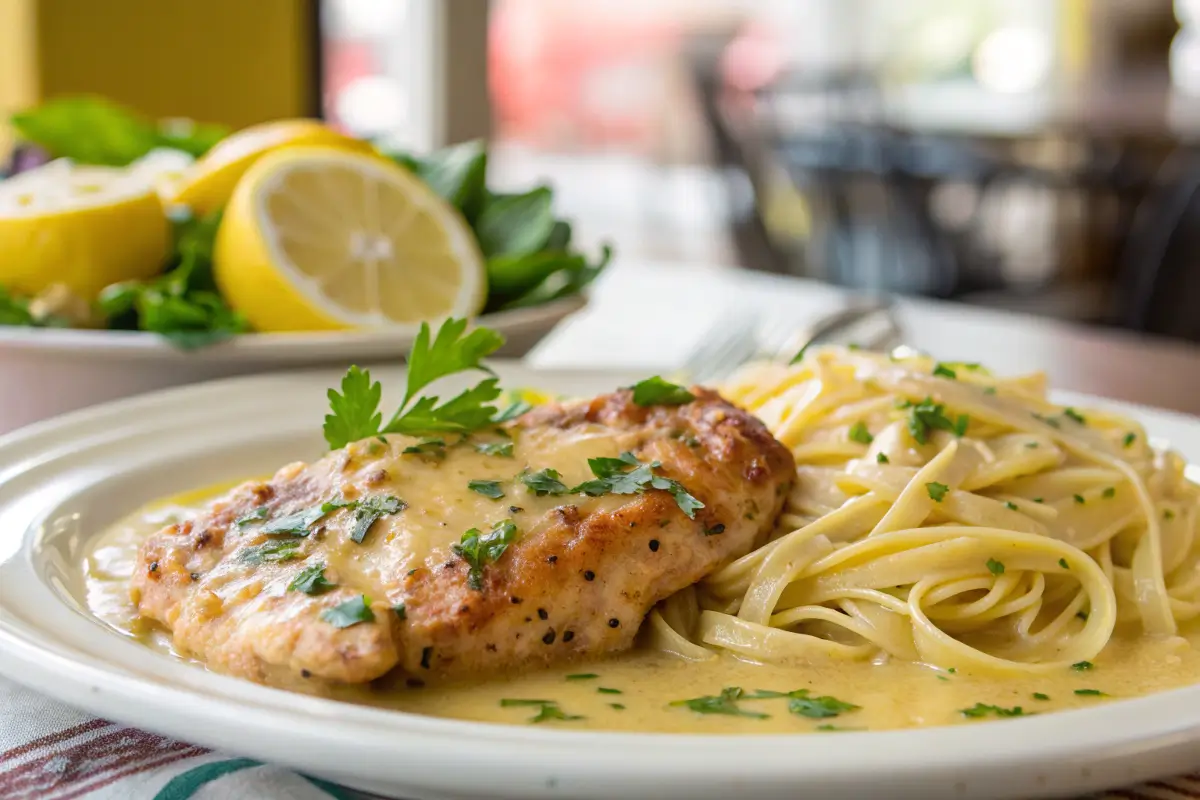When it comes to Italian cuisine, two dishes often spark curiosity and debate: Chicken Milanese and Chicken Francese. Both are delicious, but they have distinct characteristics that set them apart. In this article, we’ll dive deep into the world of these two beloved chicken dishes. We’ll explore their origins, preparation methods, flavor profiles, and even their nutritional values. By the end, you’ll have a clear understanding of what’s the difference between chicken Milanese and chicken Francese? So, let’s get started!
Understanding Chicken Milanese
What is Chicken Milanese?
Chicken Milanese is a classic Italian dish that features a breaded and fried chicken cutlet. Originating from the northern Italian city of Milan, this dish is known for its crispy exterior and tender, juicy meat. Traditionally, it’s made using thinly pounded chicken breasts, which are then coated in breadcrumbs and fried until golden brown.
Origin and History
The roots of Chicken Milanese can be traced back to the famous Cotoletta alla Milanese, a dish made with veal. Over time, chicken became a popular substitute, especially in American kitchens. This adaptation has made Chicken Milanese a staple in Italian-American restaurants, where it’s often served with a side of pasta or salad.
Key Ingredients
The main ingredients for Chicken Milanese include:
- Chicken breasts
- Breadcrumbs (often seasoned)
- Eggs
- Olive oil or butter for frying
Preparation Method
The preparation of Chicken Milanese is straightforward, making it a favorite for home cooks.
Breaded and Fried Technique
To make Chicken Milanese, you start by pounding the chicken breasts to an even thickness. Then, you dip them in beaten eggs before coating them with breadcrumbs. Finally, the breaded chicken is fried in hot oil until it’s crispy and golden. This method ensures a delightful crunch with every bite.
Serving Suggestions
Chicken Milanese is typically served with a squeeze of lemon juice on top, which brightens the flavors. It pairs wonderfully with a fresh salad or a side of pasta, making it a versatile dish for any meal.
Flavor Profile
The flavor of Chicken Milanese is a delightful combination of crispy, savory, and slightly tangy notes.
Texture and Taste
The crispy breadcrumb coating provides a satisfying crunch, while the chicken remains juicy and tender inside. The use of high-quality olive oil adds a rich flavor that enhances the overall dish.
Common Accompaniments
Common accompaniments for Chicken Milanese include:
- Arugula salad
- Marinara sauce
- Lemon wedges
In summary, Chicken Milanese is a delicious, crispy chicken dish with Italian roots that has become a favorite in many households. Now that we’ve explored this dish, let’s move on to understand Chicken Francese!
Creative Lunch Ideas for Picky Kids - Discover what to make for lunch for picky kids to ensure they enjoy their meals. What to Make for Lunch for Picky Kids
Understanding Chicken Francese

What is Chicken Francese?
Chicken Francese, also known as Chicken Française, is an Italian-American dish that features chicken breasts coated in a delicate egg batter and sautéed in a lemon-butter sauce. This dish has gained popularity in many Italian restaurants across the United States, offering a unique twist on traditional chicken preparations.
Origin and History
The origins of Chicken Francese can be traced back to Italian-American cuisine, where it is believed to have evolved from the classic Veal Francese dish. Over time, chicken became a more accessible and versatile protein, leading to the creation of the Chicken Francese variant.
Key Ingredients
The key ingredients for Chicken Francese include:
- Chicken breasts
- Eggs
- Lemon juice
- Butter
- Dry white wine (optional)
- Parsley (for garnish)
Preparation Method
The preparation of Chicken Francese is slightly different from Chicken Milanese, focusing on a delicate egg-battered technique.
Egg-Battered Technique
To make Chicken Francese, the chicken breasts are first dipped in a seasoned egg batter, which creates a light and delicate coating. The coated chicken is then sautéed in a pan with a lemon-butter sauce until golden brown and cooked through.
Serving Suggestions
Chicken Francese is often served with a side of pasta, rice, or roasted vegetables to soak up the flavorful lemon-butter sauce. The dish is typically garnished with fresh parsley, adding a touch of freshness to the overall presentation.
Flavor Profile
The flavor profile of Chicken Francese is characterized by a delicate balance of tangy, buttery, and savory notes.
Texture and Taste
The egg batter creates a light and tender coating on the chicken, while the lemon-butter sauce provides a bright and tangy flavor. The overall texture is delicate and moist, making it a popular choice for those seeking a more refined chicken dish.
Common Accompaniments
Common accompaniments for Chicken Francese include:
- Pasta (e.g., linguine, spaghetti)
- Roasted potatoes
- Sautéed spinach or other greens
Now that we’ve explored the key aspects of both Chicken Milanese and Chicken Francese, let’s dive into the differences between these two beloved Italian-American dishes.
What’s the Difference Between Chicken Milanese and Chicken Francese?

Key Differences in Preparation
The primary distinction between Chicken Milanese and Chicken Francese lies in their preparation methods.
Breading vs. Egg Battering
Chicken Milanese is characterized by a crispy, breaded coating, achieved through a process of dipping the chicken in beaten eggs and then coating it with seasoned breadcrumbs. In contrast, Chicken Francese features a delicate egg batter that creates a light and tender coating on the chicken.
Cooking Techniques
Chicken Milanese is typically fried in hot oil, resulting in a golden-brown, crispy exterior. On the other hand, Chicken Francese is sautéed in a pan with a lemon-butter sauce, which gives the dish a more refined and velvety texture.
Flavor and Texture Comparison
The preparation methods also contribute to the distinct flavor and texture profiles of these two dishes.
Crispiness and Juiciness
The breaded and fried technique of Chicken Milanese produces a satisfying crunch, while the chicken remains juicy and tender inside. Chicken Francese, with its egg batter, has a more delicate and moist texture, with a subtle tang from the lemon-butter sauce.
Sauce Variations
Chicken Milanese is often served with a simple squeeze of lemon juice, allowing the crispy coating to shine. Chicken Francese, on the other hand, is accompanied by a rich and flavorful lemon-butter sauce that adds depth to the dish.
Cultural Significance
Both Chicken Milanese and Chicken Francese have their own cultural significance and regional variations.
Regional Variations in Italy
Chicken Milanese is deeply rooted in the culinary traditions of northern Italy, particularly the city of Milan. It’s considered a classic Milanese dish and is often served as a main course or as part of a larger antipasto platter.
Popularity in American Cuisine
In the United States, both Chicken Milanese and Chicken Francese have become staples in Italian-American restaurants, catering to the tastes and preferences of American diners. These dishes have evolved to suit the local palate, sometimes incorporating additional ingredients or slight variations in preparation.
In summary, the key differences between Chicken Milanese and Chicken Francese lie in their preparation methods, flavor profiles, and cultural significance. Chicken Milanese is characterized by its crispy breaded coating and fried technique, while Chicken Francese features a delicate egg batter and a lemon-butter sauce. Both dishes, however, showcase the versatility and creativity of Italian-American cuisine.
Healthy Lunch Options for Toddlers - Explore good lunch ideas that are perfect for toddlers and will keep them satisfied. Good Lunch Time for Toddlers
Nutritional Comparison
Nutritional Overview of Chicken Milanese and Chicken Francese
When considering what’s the difference between chicken Milanese and chicken Francese? it’s also important to look at their nutritional values. Both dishes offer protein-rich options, but their preparation methods affect their overall healthiness.
Caloric Content
- Chicken Milanese: A typical serving of Chicken Milanese can contain around 400-500 calories, depending on the amount of oil used for frying and any added sides. The breading contributes to the calorie count, making it a bit heavier compared to its counterpart.
- Chicken Francese: On the other hand, Chicken Francese generally has a slightly lower caloric content, averaging between 350-450 calories per serving. The egg batter may add some calories, but the use of less oil during the sautéing process helps keep it lighter.
Health Considerations
When it comes to dietary considerations, both dishes can be modified to suit various health needs. For instance, you can choose to bake the chicken instead of frying it, which significantly reduces the amount of oil and calories. Both options can also be made gluten-free by using gluten-free breadcrumbs for Chicken Milanese or gluten-free flour for the batter in Chicken Francese.
Overall, while both Chicken Milanese and Chicken Francese are tasty options, being mindful of their nutritional content can help you make healthier choices.
FAQs
What are the main ingredients in Chicken Milanese?
Chicken Milanese primarily consists of chicken breasts, breadcrumbs, eggs, and seasonings. The breadcrumbs give it that signature crispy texture, while the eggs help the breadcrumbs adhere to the chicken.
Can Chicken Francese be made with other proteins?
Absolutely! While Chicken Francese is traditionally made with chicken, you can also use veal or even fish. The cooking method remains the same, and the results are just as delicious.
Which dish is more popular in Italian restaurants?
Both dishes are popular, but Chicken Francese tends to be more commonly found in Italian-American restaurants. Its light and flavorful sauce appeals to many diners looking for a satisfying meal.
How can I make Chicken Milanese or Chicken Francese healthier?
To make these dishes healthier, consider baking the chicken instead of frying, using whole grain breadcrumbs, or adding more vegetables to your side dishes. These small changes can enhance the nutritional value while still keeping the flavors you love.
In conclusion, understanding what’s the difference between chicken Milanese and chicken Francese? can help you appreciate each dish’s unique qualities while also enjoying them in a way that fits your dietary preferences. Both offer rich flavors and satisfying textures, making them beloved choices in Italian cuisine.
Conclusion
Summary of Key Differences
In summary, what’s the difference between chicken Milanese and chicken Francese? primarily revolves around their preparation methods and flavor profiles. Chicken Milanese features a crispy, breaded coating achieved through frying, which results in a crunchy texture and a savory taste. This dish is typically served with a simple squeeze of lemon for added brightness.
Conversely, Chicken Francese is characterized by its delicate egg batter and sautéing in a rich lemon-butter sauce, resulting in a moist and tender texture with a tangy flavor.
Final Thoughts on Choosing Between the Two Dishes
When it comes to choosing between these two delightful dishes, it really depends on your mood and preferences. If you’re in the mood for something crispy and hearty, Chicken Milanese is the way to go. On the other hand, if you prefer a lighter dish with a luxurious sauce, Chicken Francese will satisfy your cravings.
Both dishes are versatile and can be paired with various sides, making them perfect for any occasion. Ultimately, whether you opt for the crunch of Milanese or the buttery richness of Francese, you’ll be enjoying a taste of Italian-American culinary tradition that’s sure to please your palate!
How to Say Chicken Francese in Italian - Learn how to say Chicken Francese in Italian and impress your friends with your culinary vocabulary. How Do You Say Chicken Francese in Italian?
Is Chicken Francese the Same as Piccata? - Find out if Chicken Francese is the same as Piccata and what sets these dishes apart. Is Chicken Francese the Same as Piccata?







1 thought on “What’s the Difference Between Chicken Milanese and Chicken Francese?”